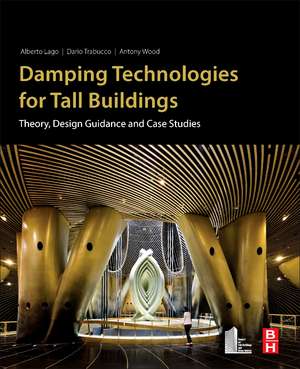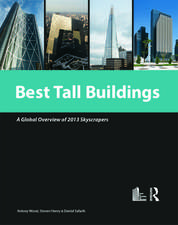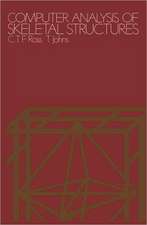Damping Technologies for Tall Buildings: Theory, Design Guidance and Case Studies
Autor Alberto Lago, Dario Trabucco, Antony Wooden Limba Engleză Paperback – 25 sep 2018
- Provides an expert guide on the selection and deployment of the various types of damping technologies
- Drawn from extensive contributions from international experts and research projects that represent the current state-of-the-art and design in damping technologies
- Includes 25+ real case studies collected with very detailed information on damping design, installation, testing and other building implications
Preț: 942.59 lei
Preț vechi: 1214.70 lei
-22% Nou
Puncte Express: 1414
Preț estimativ în valută:
180.37€ • 192.87$ • 150.38£
180.37€ • 192.87$ • 150.38£
Carte tipărită la comandă
Livrare economică 10-24 aprilie
Preluare comenzi: 021 569.72.76
Specificații
ISBN-13: 9780128159637
ISBN-10: 0128159634
Pagini: 1124
Dimensiuni: 191 x 235 x 64 mm
Greutate: 2.18 kg
Editura: ELSEVIER SCIENCE
ISBN-10: 0128159634
Pagini: 1124
Dimensiuni: 191 x 235 x 64 mm
Greutate: 2.18 kg
Editura: ELSEVIER SCIENCE
Public țintă
Structural Engineers, specializing in design, reliably and structural safetyCuprins
Part 1: Need for Supplementary Damping Devices in Tall Buildings1. Effect of Damping on Building Response2. Inherent Damping of Tall Buildings3. Improved Resiliency Through damping4. Wind-Excited Motion and Performance Objectives5. Earthquake-Excited Motion and Performance Objectives6. Practical and Economic Considerations7. Damping System Sustainability8. Alternative to Damping Devices
Part 2: Introduction to Supplementary Damping Devices9. Passive Damping Systems10. Active, Semi-Active, and Hybrid Systems11. Multiple Damping Strategies12. Comparison of Dampers in Tall Buildings
Part 3: Design Procedures of Buildings with Damping Devices13. Available Codes and Design Tools14. Passive Damping Systems15. Active, Semi-Active and Hybrid Systems16. Tall Building Retrofit17. Damper Strategy Optimization
Part 4: Building System Interaction18. Architectural Appearance19. Elevators20. Mechanical Systems21. Façade
Part 5: Testing, Inspection and Maintenance21. Pre Installation Tests22. Commissioning and System Tuning23. Fatigue of Dampers24. Building Health Monitoring25. Ongoing Maintenance26. Post Extreme Event Inspections27. Transportation, Construction and Care of Works28. USRC Rating System
Part 6: Case Studies29. Distributed Damping Systems30. Isolated Damping Systems
Part 6: Future of Damped Systems31. Wind Design32. Seismic Design33. Future Design
Part 7: Conclusions34. Trend Data for Tall Buildings with Damped Devices35. Design Considerations36. Design Optimization
Part 2: Introduction to Supplementary Damping Devices9. Passive Damping Systems10. Active, Semi-Active, and Hybrid Systems11. Multiple Damping Strategies12. Comparison of Dampers in Tall Buildings
Part 3: Design Procedures of Buildings with Damping Devices13. Available Codes and Design Tools14. Passive Damping Systems15. Active, Semi-Active and Hybrid Systems16. Tall Building Retrofit17. Damper Strategy Optimization
Part 4: Building System Interaction18. Architectural Appearance19. Elevators20. Mechanical Systems21. Façade
Part 5: Testing, Inspection and Maintenance21. Pre Installation Tests22. Commissioning and System Tuning23. Fatigue of Dampers24. Building Health Monitoring25. Ongoing Maintenance26. Post Extreme Event Inspections27. Transportation, Construction and Care of Works28. USRC Rating System
Part 6: Case Studies29. Distributed Damping Systems30. Isolated Damping Systems
Part 6: Future of Damped Systems31. Wind Design32. Seismic Design33. Future Design
Part 7: Conclusions34. Trend Data for Tall Buildings with Damped Devices35. Design Considerations36. Design Optimization






